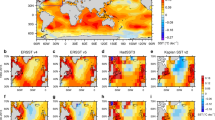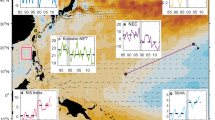Abstract
Abrupt changes in the African monsoon can have pronounced socioeconomic impacts on many West African countries. Evidence for both prolonged humid periods and monsoon failures have been identified throughout the late Pleistocene and early Holocene epochs1,2. In particular, drought conditions in West Africa have occurred during periods of reduced North Atlantic thermohaline circulation, such as the Younger Dryas cold event1. Here, we use an ocean–atmosphere general circulation model to examine the link between oceanographic changes in the North Atlantic Ocean and changes in the strength of the African monsoon. Our simulations show that when North Atlantic thermohaline circulation is substantially weakened, the flow of the subsurface North Brazil Current reverses. This leads to decreased upper tropical ocean stratification and warmer sea surface temperatures in the equatorial South Atlantic Ocean, and consequently reduces African summer monsoonal winds and rainfall over West Africa. This mechanism is in agreement with reconstructions of past climate. We therefore suggest that the interaction between thermohaline circulation in the North Atlantic Ocean and wind-driven currents in the tropical Atlantic Ocean contributes to the rapidity of African monsoon transitions during abrupt climate change events.
This is a preview of subscription content, access via your institution
Access options
Subscribe to this journal
Receive 12 print issues and online access
$259.00 per year
only $21.58 per issue
Buy this article
- Purchase on Springer Link
- Instant access to full article PDF
Prices may be subject to local taxes which are calculated during checkout



Similar content being viewed by others
References
Grasse, F. Hydrological changes in the African tropics since the Last Glacial Maximum. Quat. Sci. Rev. 19, 189–211 (2000).
deMenocal, P. et al. Abrupt onset and termination of the African Humid Period: Rapid climate response to gradual insolation forcing. Quat. Sci. Rev. 19, 347–361 (2000).
Philander, S. G. El Niño, La Niña, and the Southern Oscillation 289 (Academic, San Diego, 1990).
Mitchell, T. P. & Wallace, J. M. On the annual cycle in equatorial convection and sea surface temperature. J. Clim. 5, 1140–1152 (1992).
Vizy, E. K. & Cook, K. H. Development and application of a mesoscale climate model for the tropics: Influence of sea surface temperature anomalies on the West Africa Monsoon. J. Geophys. Res. 107, 4023–4044 (2002).
Giannini, A., Saravanan, R. & Chang, P. Oceanic forcing of Sahel Rainfall on interannual to interdecadal timescales. Science 302, 1027–1030 (2003).
Weijers, J. W. H., Schefuß, E., Schouten, S. & Damsté, J. S. S. Coupled thermal and hydrological evolution of tropical Africa over the last deglaciation. Science 315, 1701–1704 (2007).
Lea, D. W., Pak, D. K., Peterson, L. C. & Hughen, K. A. Synchroneity of tropical and high-latitude Atlantic temperatures over the Last Glacial termination. Science 301, 1361–1364 (2003).
Rühlemann, C. et al. Intermediate depth warming in the tropical Atlantic related to weakened thermohaline circulation: Combining paleoclimate data and modeling results for the last deglaciation. Paleoceanography 19, 1025–1034 (2004).
Weldeab, S., Schneider, R. R. & Kölling, M. Deglacial sea surface temperature and salinity increase in the western tropical Atlantic in synchrony with high latitude climate instabilities. Earth Planet. Sci. Lett. 241, 699–706 (2006).
Schefuß, E., Schouten, S. & Schneider, R. R. Climate controls on central African hydrology during the past 20,000 years. Nature 437, 1003–1006 (2005).
McManus, J. F., Francois, R., Gherardi, J.-M., Keigwin, L. D. & Brown-Leger, S. Collapse and rapid resumption of Atlantic meridional circulation linked to deglacial climate changes. Nature 428, 834–837 (2004).
Came, R. E. et al. in Ocean Circulation: Mechanisms and Impacts (eds Schmittner, A., Chiang, J. C. H. & Hemming, S. R.) (AGU Monograph, Vol. 173, American Geophysical Union, Washington DC, 2007).
Stouffer, R. J. et al. Investigating the causes of the thermohaline circulation to past and future climate changes. J. Clim. 19, 1365–1387 (2006).
Manabe, S. & Stouffer, R. J. Coupled ocean–atmosphere model response to freshwater input: Comparison to Younger Dryas event. Paleoceanography 12, 321–336 (1997).
Zhang, R. & Delworth, T. L. Simulated tropical response to a substantial weakening of the Atlantic thermohaline circulation. J. Clim. 18, 1853–1860 (2005).
Chiang, J. C. H., Biasutti, M. & Battisti, D. S. Sensitivity of the Atlantic ITCZ to Last Glacial Maximum boundary conditions. Paleoceanography 18, 1094 (2003).
Bush, A. B. G. Extratropical influences on the El Niño—Southern Oscillation through the Late Quaternary. J. Clim. 20, 788–800 (2007).
Chiang, J. C. H., Cheng, W. & Bitz, C. M. Teleconnection mechanism to the tropical Atlantic sector from Atlantic thermohaline adjustment. Geophys. Res. Lett. 35, L07704 (2008).
Kawase, M. Establishment of deep ocean circulation driven by deep-water production. J. Phys. Oceanogr. 17, 2297–2317 (1987).
Timmermann, A. et al. Mechanisms for millennial-scale global synchronization during the last glacial period. Paleoceanography 20, PA4008 (2005).
Zhang, D., McPhaden, M. J. & Johns, W. E. Observational evidence for flow between the subtropical and tropical Atlantic: The Atlantic Subtropical Cells. J. Phys. Oceanogr. 33, 1783–1797 (2003).
Fratantoni, D. M., Johns, W. E., Townsend, T. L. & Hurlburt, H. E. Low-latitude circulation and mass transport pathways in a model of the tropical Atlantic Ocean. J. Phys. Oceanogr. 30, 1944–1966 (2000).
Hazeleger, W. & Drijfhout, S. Subtropical cells and meridional overturning circulation pathways in the tropical Atlantic. J. Geophys. Res. 111, 3013–3025 (2006).
Jochum, M. & Malanotte-Rizzoli, P. Influence of the meridional overturning circulation on tropical–subtropical pathways. J. Phys. Oceanogr. 31, 1313–1323 (2001).
Haarsma, R. J., Campos, E. J. D., Hazeleger, W. & Severijns, C. A. Influence of the meridional overturning circulation on tropical atlantic climate and variability. J. Clim. 21, 1403–1416 (2008).
Delworth, T. et al. GFDL’s CM2 global coupled climate models. Part I: Formulation and simulation characteristics. J. Clim. 19, 643–674 (2006).
Zhang, R. Anticorrelated multidecadal variations between surface and subsurface tropical North Atlantic. Geophys. Res. Lett. 34, L12713 (2007).
Acknowledgements
We wish to thank J. Yin for providing us with the extra water-hosing experiment output of the GFDL CM2.1 model. This work is supported by the National Science Foundation, Grant No. OCE-0623364 and ATM-0337846, the Climate Program Office, US National Oceanic and Atmospheric Administration, Grant No. NA050AR4311136 and the Office of Science (BER), US Department of Energy, Grant No. DE-FG02-07ER64443.
Author information
Authors and Affiliations
Corresponding author
Supplementary information
Supplementary Information
Supplementary figures S1-S3 (PDF 485 kb)
Rights and permissions
About this article
Cite this article
Chang, P., Zhang, R., Hazeleger, W. et al. Oceanic link between abrupt changes in the North Atlantic Ocean and the African monsoon. Nature Geosci 1, 444–448 (2008). https://doi.org/10.1038/ngeo218
Received:
Accepted:
Published:
Issue Date:
DOI: https://doi.org/10.1038/ngeo218
This article is cited by
-
Energetic overturning flows, dynamic interocean exchanges, and ocean warming observed in the South Atlantic
Communications Earth & Environment (2023)
-
Weakening of the Atlantic Niño variability under global warming
Nature Climate Change (2022)
-
Meridional changes in the South Atlantic Subtropical Gyre during Heinrich Stadials
Scientific Reports (2021)
-
Ocean model resolution dependence of Caribbean sea-level projections
Scientific Reports (2020)
-
Surface cooling caused by rare but intense near-inertial wave induced mixing in the tropical Atlantic
Nature Communications (2020)



